For the 2025 school year, there are 2 public elementary schools serving 510 students in Union School District. This district's average elementary testing ranking is 4/10, which is in the bottom 50% of public elementary schools in Pennsylvania.
Public Elementary Schools in Union School District have an average math proficiency score of 30% (versus the Pennsylvania public elementary school average of 35%), and reading proficiency score of 52% (versus the 54% statewide average).
Minority enrollment is 4% of the student body (majority Black), which is less than the Pennsylvania public elementary school average of 42% (majority Hispanic and Black).
Overview
This School District
This State (PA)
# Schools
2 Schools
2,145 Schools
# Students
510 Students
1,108,977 Students
# Teachers
44 Teachers
82,943 Teachers
Student : Teacher Ratio
12:1
12:1
District Rank
Union School District, which is ranked within the bottom 50% of all 675 school districts in Pennsylvania (based off of combined math and reading proficiency testing data) for the 2021-2022 school year.
The school district's graduation rate of 80-89% has decreased from 90% over five school years.
Overall District Rank
#428 out of 684 school districts
(Bottom 50%)
(Bottom 50%)

Math Test Scores (% Proficient)
29%
36%
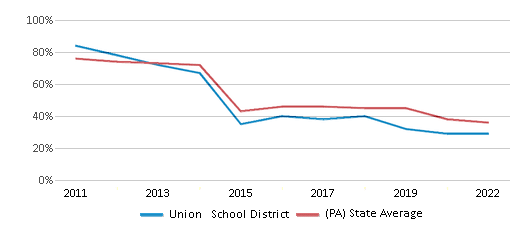
Reading/Language Arts Test Scores (% Proficient)
52%
55%
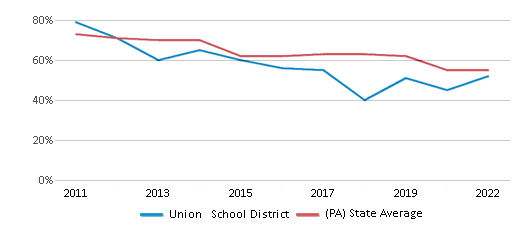
Science Test Scores (% Proficient)
50-54%
57%
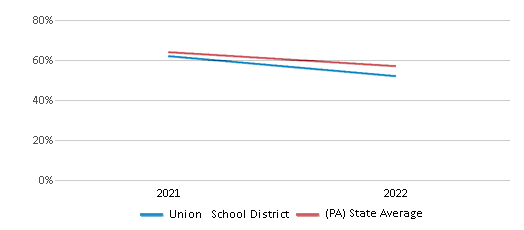
Graduation Rate
80-89%
87%
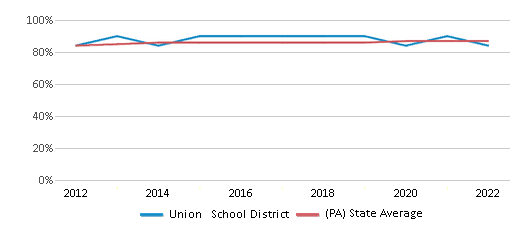
Students by Ethnicity:
Diversity Score
0.07
0.61
# American Indian Students
n/a
2,278 Students
% American Indian Students
n/a
n/a
# Asian Students
n/a
51,838 Students
% Asian Students
n/a
5%
# Hispanic Students
4 Students
173,776 Students
% Hispanic Students
1%
16%
# Black Students
7 Students
169,696 Students
% Black Students
1%
15%
# White Students
492 Students
645,871 Students
% White Students
97%
58%
# Hawaiian Students
n/a
965 Students
% Hawaiian Students
n/a
n/a
# Two or more races Students
7 Students
63,991 Students
% of Two or more races Students
1%
6%
Students by Grade:
# Students in PK Grade:
-
7,744
# Students in K Grade:
21
110,287
# Students in 1st Grade:
38
120,767
# Students in 2nd Grade:
45
126,133
# Students in 3rd Grade:
34
120,907
# Students in 4th Grade:
31
125,574
# Students in 5th Grade:
49
126,000
# Students in 6th Grade:
37
126,698
# Students in 7th Grade:
57
94,854
# Students in 8th Grade:
35
93,972
# Students in 9th Grade:
47
16,255
# Students in 10th Grade:
33
14,467
# Students in 11th Grade:
40
12,872
# Students in 12th Grade:
43
12,447
# Ungraded Students:
-
-
District Revenue and Spending
The revenue/student of $23,886 is higher than the state median of $23,696. The school district revenue/student has grown by 11% over four school years.
The school district's spending/student of $25,384 is higher than the state median of $23,119. The school district spending/student has grown by 11% over four school years.
Total Revenue
$12 MM
$39,541 MM

Spending
$13 MM
$38,578 MM

Revenue / Student
$23,886
$23,696

Spending / Student
$25,384
$23,119
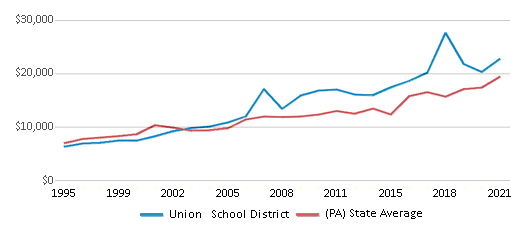
Best Union School District Public Elementary Schools (2025)
School
(Math and Reading Proficiency)
(Math and Reading Proficiency)
Location
Grades
Students
Rank: #11.
Sligo Elementary School
(Math: 30-34% | Reading: 50-54%)
Rank:
Rank:
4/
Bottom 50%10
2013 Madison Street Extension
Sligo, PA 16255
(814) 745-2152
Sligo, PA 16255
(814) 745-2152
Grades: K-5
| 218 students
Rank: #22.
Union High School
(Math: 25-29% | Reading: 50-54%)
Rank:
Rank:
4/
Bottom 50%10
354 Baker Street Suite 1
Rimersburg, PA 16248
(814) 473-3121
Rimersburg, PA 16248
(814) 473-3121
Grades: 6-12
| 292 students
Recent Articles

Year-Round Or Traditional Schedule?
Which is more appropriate for your child? A year-round attendance schedule or traditional schedule? We look at the pros and cons.

Why You Should Encourage Your Child to Join a Sports Team
Participating in team sports has a great many benefits for children, there is no doubt. In this article you will learn what those benefits are.

White Students are Now the Minority in U.S. ĺŇ”őŐŚ”żs
Increasing birth rates among immigrant families from Asia and Central and South America, combined with lower birth rates among white families, means that for the first time in history, public school students in the United States are majority-minority. This shift in demographics poses difficulties for schools as they work to accommodate children of varying language abilities and socio-economic backgrounds.





